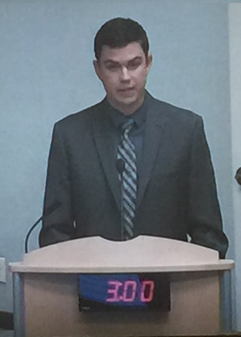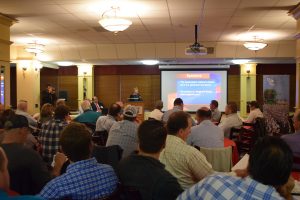Next Week, the Cal Poly Center for Sustainability will be holding a Soil Health Assessment Field Day at Macon Seed in Turlock. The event will feature plant pathologist and Denele Analytical Director, Joe Mullinax, USDA-NRCS Regional Soil Health Specialist, Zahangir Kabir, as well as Cal Poly staff. The event will focus on the contribution of biology and organic matter as it relates to soil health, how they can be measured and supported through sustainable agricultural management practices, as well as a variety of tools available now that assess soil health. The event will be held Thursday, May 25th at Macon Seed, located in Turlock, CA. For more information on the event and registration information, please visit: http://cfs.calpoly.edu/soilsworkshops.html
NEWS & ISSUES
CCGGA Never Stops Working
After two days at the State Capitol with Board Members discussing critical issues affecting the cotton industry, the Association hurried back to Fresno yesterday to attend a special Air Resources Board (ARB) Meeting on the State Implementation Plan (SIP) for the San Joaquin Valley. The evening meeting which began at 5:00 pm included a presentation by the ARB and discussions on the need for a mandatory farm equipment replacement rule and increased requirements for Conservation Management Practices (CMPs). Then it was opened to public comment, where industry was outnumbered 10 to 1 and the attack on agriculture began. Several environmental groups berated the San Joaquin Valley Air Pollution Control District and ARB for not mandating the replacement of farm equipment and requiring more CMPs. After 3 hours of this testimony, Association President/CEO Roger Isom addressed the crowd by stressing the steps that farmers have taken to clean up the air in advance of these regulations. Isom talked about the reductions achieved through the CMP rule and practices developed hand in hand with the industry, and the tremendous reductions achieved through the incentive programs such as Carl Moyer and the EQIP program through NRCS. Isom also discussed the conversion of ag pumps from diesel to electric through the Ag-ICE program and the current work on Ag-ICE 2.0. The Nisei Farmers League also testified in opposition to the proposed control measures and the push by the environmental community to increase regulations on agriculture.
Association Voices Concern Over PG&E Rate Increase
Yesterday, the California Public Utilities Commission (CPUC) held a meeting in Merced to discuss the proposed revenue requirements for PG&E’s 2017 General Rate Case (GRC). In Phase 1 of the GRC, PG&E asked for an increase of $85.7 million over present rates, followed by additional increases of $444 million in 2018 and $361 million in 2019. While the public testimony was especially light, Association President/CEO Roger Isom was there and voiced the agricultural industry’s concerns over the continued increase in rates over the past 15 years. Isom informed the PUC Commissions that average electricity rates for agriculture have increased from an average of 11.7 cents per kilowatt hour in 2000 to over 18 cents per kilowatt hour in 2017. The total amount paid by farmers in the PG&E territory was around $500 million in 2004 and over $1.1 billion in 2014! Coming increases in the Renewable Portfolio Standard (RPS) and further impacts from tightening greenhouse gas regulations will only serve to increase rates even further. Isom told the Commissioners this must be considered and that agriculture cannot pass along the cost and has passed the point of being competitive. The PUC can no longer ignore this!
Association Testifies Once Again on District’s PM2.5 Plan
The Association continued its fight against further regulation of PM2.5 emissions from agricultural operations testifying before the San Joaquin Valley Air Pollution Control District today at the District workshop on the PM2.5 State Implementation. Association President/CEO Roger Isom testified against the mandatory replace of all tractors and harvesters, despite an individual alleging to be an almond grower telling the District that every grower should be mandated to purchase new low emitting almond harvesting equipment. Instead, Association Director of Technical Services Christopher McGlothlin testified that incentives have been used to get equal or greater emission reductions on a voluntary basis. McGlothlin also commented that incentives allow farmers to purchase new equipment sooner then they normally would and the industry is working with the District and USDA NRCS to strengthen and support the incentive program for tractors and harvesters. Isom also commented against the proposal to increase fugitive dust requirements for PM2.5, as the science does not support this. This is another in a series of SJVAPCD and CARB workshops, including two more to be held next week. As has been the case in all of the previous workshops the Association will be present to fight these proposed far reaching regulations.
Association Opposes Cal/OSHA Indoor Heat Stress Regulation
The Association joined several other agricultural organizations in submitting written comments opposing CalOSHA’s proposed “Heat Illness Prevention in Indoor Places of Employment” standard. Last year, the legislature in its infinite wisdom decided it was necessary for California to not only be the only state with an outdoor heat illness regulation, they passed legislation to mandate the Cal/OSHA adopt an “indoor heat illness” regulation. Accordingly, Cal/OSHA has now drafted and released a proposed standard entitled Heat Illness Prevention in Indoor Places of Employment. If enacted, the proposed standard would require employers to conduct the following:
- Establish, implement and maintain an effective heat illness prevention plan for “indoor heat illness”
- Measure the wet bulb globe temperature (WBGT)
- Identify each individual employee’s work activity levels and clothing adjustment factors
- Conduct heat stress hazard assessment of all facilities
- Provide access to potable drinking water
- Provide for preventative cool-down rest periods of no less than 5 minutes
- Establish effective first-aid and emergency response procedures for responding to possible heat illness
- Provide engineering controls to reduce employee exposures to reduce heat stress including but not limited to: isolation of hot processes or work areas, shielding of radiant heat sources, insulating hot objects, and local exhaust ventilation
- Provide administrative controls including but not limit to: reduced activity levels, work-rest schedules and cooled rest areas
- Remind employees throughout the work shift to drink plenty of water
- Conduct pre-shift meetings to review high heat procedures
- Make personal protective equipment, such as water-cooled garments, air-cooled garments, ice-packet vests, wetted over-garments and heat-reflective clothing available to employees exposed to high heat sources
- Keep records of heat stress hazard assessments and trainings
The Association has reviewed the proposed standard and attended the recent workshop held in Oakland on the proposed standard. Based upon that review we have serious concerns with the proposed regulations and the impact they could have on agricultural operations, including tree nut farms, hullers and processors. We feel strongly that the proposed standard is not warranted or justified in the agricultural industry, is overly cumbersome and too complicated and costly to implement.
EPA Denies Activist Petition Aimed to Ban Chlorpyrifos
The Environmental Protection Agency (EPA) Administrator Scott Pruitt signed an order denying the activist petition that sought to ban chlorpyrifos (Lorsban). This long fought battle starting in October 2015 was begun with pressure from Natural Resources Defense Council (NRDC) and the Pesticide Action Network North America (PANNA) to submit a petition proposing to revoke all U.S. food tolerances of chlorpyrifos, in essence regulating it out of use. As one of the most widely used pesticides across the world, California Cotton Ginners and Growers Association (CCGGA) and other representatives of the agricultural industry defended the product and grower practices relentlessly in an effort to keep the product available. The largest issues being the main argument in the petition was centered on a study that lacked availability of raw data, duplication or further review. CCGGA and others recently submitted comments citing issues with this data, today’s news shows they listened. EPA’s denial of the petition is based off of the foundation in which EPA was created on, relying on sound-science and a transparent process. EPA will now direct its efforts to updating and revising its human health assessment for chlorpyrifos under the standard procedures of the ongoing registration review process, scheduled for completion on October 1, 2022. This is great news for producers and shows the EPA’s redirection towards supporting a scientific process!
High VOC Restrictions to Continue in SJV Through 2017
The Department of Pesticide Regulations released their Annual Volatile Organic Compounds (VOC) Emissions Inventory Report. Pursuant to the State Implementation Plan goals the San Joaquin Valley, one of five ozone nonattainment areas (NAAs) in California, was to have VOC emissions no greater that 18.1 tons/day. This is the equivalent to a 12 percent reduction from 1990. In 2013 the San Joaquin Valley NAA exceeded this benchmark triggering additional restrictions on non-fumigant pesticides identified as high-VOC. While emissions went down in 2015, the regulations require that the high-VOC restrictions remain in effect from May-October 2017. However, the exemption for use on high-VOC Chlorpyrifos (Lorsban) for use on late season aphid remains in effect.
Water Announcement Tempers Enthusiasm on California Cotton Acreage Increase
The good news is that cotton acreage looks like it will increase for the 2nd year in a row. Record rainfall and snowpack, coupled with stable cotton prices and falling prices from other commodities are leading to an increase in cotton acreage. However, that increase is being tempered by a disappointing, less than expected water allotment from the Central Valley Project (CVP) of only 65%, and the potential flooding in the Tulare lake bottom in Kings County.
As of today, all indicators of water supply are above normal. Way above. Currently, the statewide snowpack is at 164% of average, while statewide rainfall is over 200% of average to date, with Blue Canyon in the northern Sierras at 245% and Mariposa in the central Sierras at 211% of average to date. Reservoirs are all higher than average with Shasta at 87%, Oroville at 74%, New Melones at 77%, Don Pedro at 88%, and most importantly San Luis is at 98%. Flood releases are occurring at many of these dams including Shasta, Oroville, Folsom, and Millerton.
Yet, with all of these positive factors, farmers relying upon the CVP water are only going to receive 65% of their allotment. While industry is thankful for the water, it is inconceivable that the number isn’t closer to 80% or more. Unfortunately, this will have a direct impact on the cotton plantings for this coming year.
According to preliminary planting intentions survey conducted by the California Cotton Ginners and Growers Association this past month, the Association is currently estimating approximately 186,000 acres of pima and 70,000 acres of upland statewide for the 2017 cotton season. This survey is based on surveys from all of the gins in California prior to planting and a lot can happen between now and when things are actually planted. If it plays out, it will represent a 22% increase in pima acreage and a 6% increase in upland acreage in California as compared to 2016.
Successful Sticky Cotton Summit at Fresno State
The California cotton industry gathered at Fresno State to participate in the 2017 Sticky Cotton Summit hosted by California Cotton Ginners and Growers Association (CCGGA). Dean of the Jordan College of Agricultural Sciences and Technology Dr. Sandra Witte welcomed the group to Fresno State campus and thanked the attendees for the ongoing support that the agriculture industry has shown for the Jordan College. Attendees of the summit had the opportunity to meet Dr. Margaret Ellis of Fresno State. Dr. Ellis is the recipient of a CCGGA research grant surrounding Fusarium in cotton and fungicide efficacy, she is the first professor at Fresno State to receive a grant from the Association.
As the program for the Sticky Cotton Summit got underway panels from the mill, merchant, ginner, grower, PCA and UCCE offered their perspective on how sticky cotton impacts their respective segments of the industry. In addition, USDA-ARS researcher Chris Delhom demonstrated the diverse testing methodologies that are present throughout the country, in part creating an issue of developing uniform testing standards for the industry to adopt. The conclusion of the summit resulted in an open group discussion that led to action items for the industry and CCGGA to pursue. The items included looking into a uniform gin level penalty for sticky cotton delivered, conducting outreach, education and retraining on thresholds and best management practices for growers, seeking additional research dollars to invest in sticky cotton testing measures as well as increasing awareness in order to have more open communication surrounding the issue. CCGGA was directed to develop an industry subcommittee to ensure the progress of the action items outlined from the day’s discussion. We will be sure to provide updates and progress as these items are pursued.
Following the summit Fresno State’s Ag One Foundation welcomed members and staff of CCGGA to tour Fresno State’s 1,000-acre farm, the Fresno State Gibson Farm Market as well as a tour of the new Jordan Agricultural Research Center. The tour showcased the diversity of the agricultural operations students have access to use as well as the vision for the agricultural centered research to be conducted on campus for years to come.
Air District Puts Everything on the Table to Address PM2.5
Succumbing to the pressure of having to attain an impossible air quality standard with very little assistance from the California Air Resources Board (CARB) or Federal EPA, the San Joaquin Valley Air Pollution Control District unveiled a long list of far reaching control measures to reduce PM2.5. Those measures up for discussion include:
- Replace all almond harvesters in Valley with latest low-emitting harvester technologies
- Install PM control technology on larger under-fired charbroilers installed within last 10-15 years (360 out of 1,800)
- Enhance CMPs for ag operations to reduce directly emitted PM
- Replace 23,628 older high emitting residential wood-burning devices with cleaner devices
- Electrify 1,053 ag pump engines in areas impacting peak PM2.5 sites where access to electricity is available
- Lower NOx limit for container glass plants
- Lower NOx emissions from various boiler, steam generator, process heaters > 5 MMBtu/hr
- Lower NOx emissions from various boiler, steam generator, process heaters 2 to 5 MMBtu/hr
- Install ultra-low NOx flare technology and require additional flare minimization practices
- Lower NOx emissions from various non-agricultural engine categories
- Replace 74,912 heavy heavy-duty trucks with upcoming 0.02 g/bhp-hr ultra-low NOx trucks that are 90% cleaner than 2010 trucks recently required by ARB’s Truck and Bus Regulation
- Replace 110,000 medium heavy-duty trucks with upcoming 0.02 g/bhphr ultra-low NOx trucks that are 90% cleaner than 2010 trucks recently required by ARB’s Truck and Bus Regulation
- Replace 102,936 light heavy-duty trucks with upcoming 0.02 g/bhp-hr ultra-low NOx trucks that are 90% cleaner than 2010 trucks recently required by ARB’s Truck and Bus Regulation
- Install 2,622 natural gas fueling stations for deployment of 0.02 g/bhp-hr ultra-low NOx heavy duty trucks
- Replace 320,000 passenger vehicles with zero-emission vehicles
- Replace 76 locomotives with new Tier 4 locomotives
The price tag for all of these measures, which the District says need to be done by 2019? More than $51 billion! The District staff laid this out today to the Governing Board stating their back is up against the wall, but realizes the above listed measures are too costly and impractical to achieve without incentive monies. Unfortunately, the District will face federal sanctions unless they can get into attainment of the PM2.5 standard by 2019. CCGGA President/CEO Roger Isom testified before the Governing Board on the issue stating that the almond harvesting and CMP modifications have not yet been proven to reduce PM2.5 emissions and further research is needed. Isom also expressed concerns with rising electricity prices that may dissuade farmers from switching from diesel to electric, and encouraged the District to help on that particular issue. Later in the same meeting, the District brought up but did not adopt such “draconian measures” as “no farm days”, “no construction days” and “no drive days” where Interstate 5 and Highway 99 would be shut down. Again, the District was trying to state the seriousness of the issue while placing boundaries on what can and cannot be done. The District will have to adopt their PM2.5 plan demonstrating attainment by August of this year.


